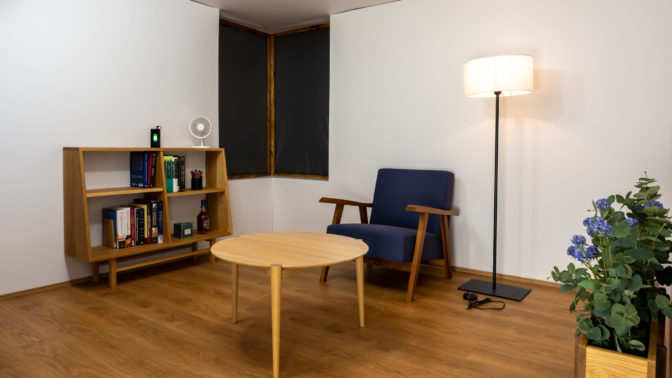Wireless electricity and safety: A Q&A with Alanson Sample

A wireless power system developed by researchers at the University of Tokyo and University of Michigan can power cell phones, lights and other devices by using magnetic fields to deliver electricity over the air. A recent study showed that the system can safely deliver at least 50 watts of power.
We sat down with Alanson Sample, a professor of Computer Science and Engineering at U-M and an author on the paper, to find out how all that power can travel through the air without endangering the people in its path.
How did you determine that your charging room is safe?
In the United States, we have strict safety limits on the amount and type of electromagnetic energy that electronic devices can emit. They’re set by the Federal Communications Commission with guidance from the National Institutes of Health and the Institute of Electrical and Electronics Engineers.
For this work, we used the most restrictive standard, the Specific Absorption Rate, or SAR. SAR is a measure of how much electromagnetic energy is absorbed by the body. For uncontrolled exposure, the whole-body average SAR limit is 0.08 watts per kilogram, and the peak limit for any point on the body is 1.6 watts per kilogram.
These limits apply to cell phones, microwaves—anything that emits electromagnetic energy. For these frequency ranges, the safety concern is that too much electromagnetic energy can heat body tissue.
To make sure the charging room doesn’t exceed those limits, we ran a widely used computer simulation to determine how much energy a person standing in in the charging room would absorb. We found that we could deliver at least 50 watts of power over the air without exceeding the whole-body or single-point SAR limits.

How does the energy I’d be exposed to in your charging room compare to the energy I’m exposed to when I use my cell phone?
Cell phones must comply with the same SAR standards that we used in the study. So the charging room would expose you to an equal or smaller amount of energy compared to a cell phone.
But how can something that delivers enough power to charge my cell phone be exposing me to less energy than the cell phone itself?
Your cell phone uses a simple antenna to emit electromagnetic energy in an uncontrolled environment. And like all common electronic devices, the relationship between the intensity of the electric and magnetic fields is fixed. To emit more magnetic energy, the phone must emit more electric energy as well. That means it’s very limited in how much energy it can deliver safely.
The charging room is different because we have control over the entire environment. So we designed a system of conductors and capacitors that changes the relationship between the electric and magnetic fields. It creates a magnetic field that resonates through the whole room, but it confines the electric field to capacitors placed in the walls. This way, the magnetic field can deliver power without exposing people in the room to a strong electric field.
In addition, the charging room operates at a much lower frequency than a cell phone. So the electric fields that are present interact with the body less than those put out by a cell phone. Finally, cell phones are held right up against your head, so they’re a more concentrated source of electromagnetic energy.
What additional testing would be required to make something like this commercially available?
We’re a long way from that. A commercial device would need to get full FCC approval, and that looks at many more factors in addition to SAR—duration and time, usage model, all those sorts of things.
But the goal of this project wasn’t to build a product that’s ready for prime time. It was to answer the question “Is it possible to safely deliver useful amounts of wireless power throughout an entire room?” And the answer to that question appears to be “yes.” We may not know the exact power levels a final product will be able to deliver but this initial study gives us confidence moving forward.
Our next steps are to refine the system and develop some preliminary applications that can begin to use this technology on a small scale—for example, we’re looking at toolboxes that wirelessly charge tools placed inside, wirelessly powering medical implants, and charging swarms of small robots.
Developing new technology is a very long process, but the important thing is to keep moving forward. We’re doing that, and I’m excited about what’s on the horizon for wireless charging.
 MENU
MENU